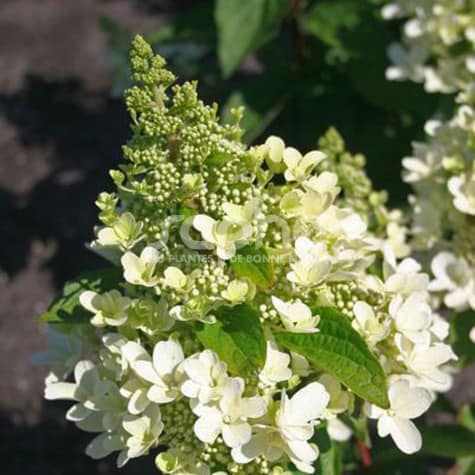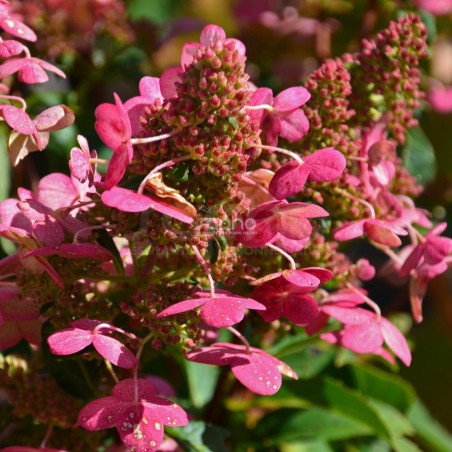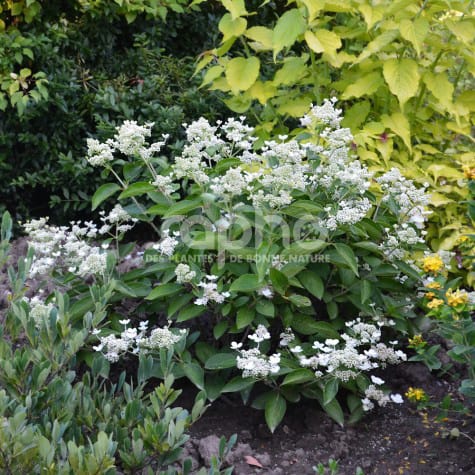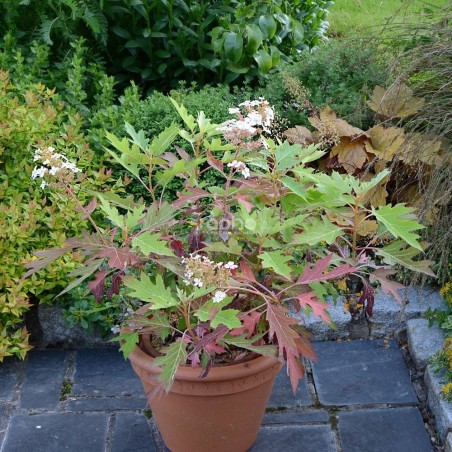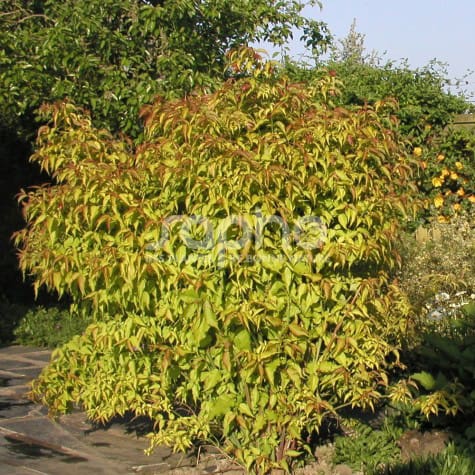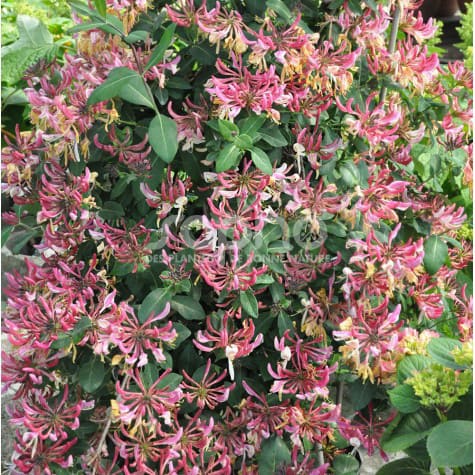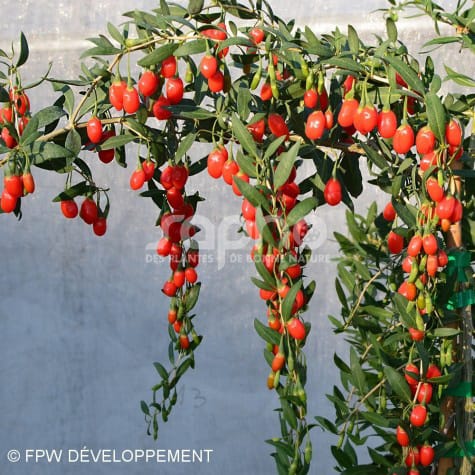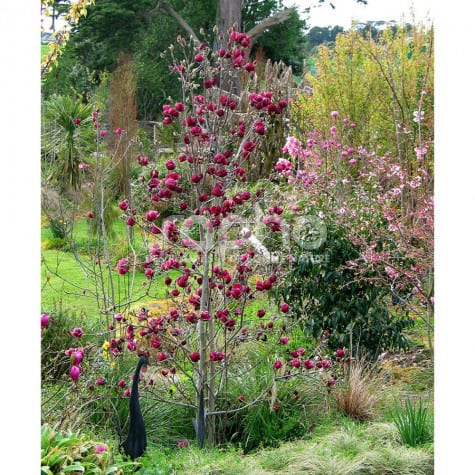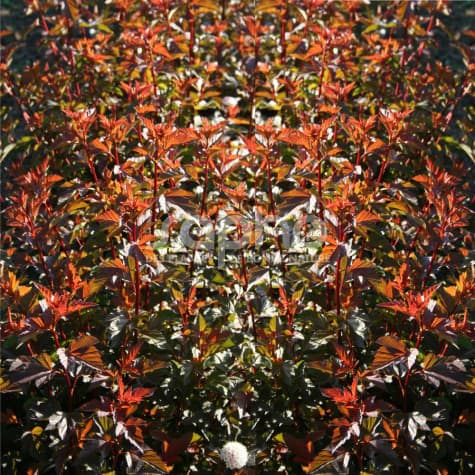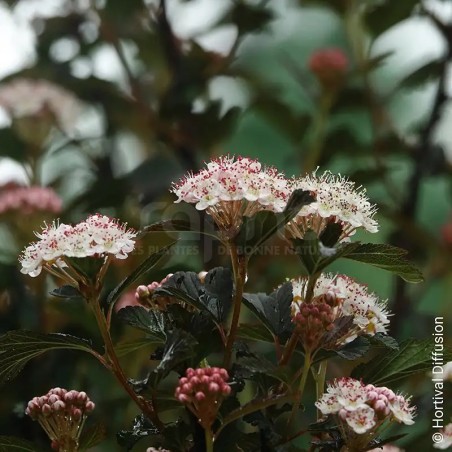A compact novelty with evolving colours
Magical Vesuvio is a handsome novelty of Hydrangea paniculata with evolving colours. The panicles carry sterile and fertile flowers. Readily flowering, its strongly cone-shaped panicles change during the summer from white to dark red. Its compact shape will grow no higher and wider than 1.5 m and is thus ideal for boxes, small gardens or flowering hedges.
Filter By
Foliage
Position
Where to find Sapho plants ?
For young plants
You will find the names of Sapho-licensed nurserymen at the bottom of each variety sheet.
For available plants
Please ask your nursery suppliers.
Each licensed propagator is free to market his young plants to all his customers.
Categories
Menu
All our varieties
A very early white and a summery red!Prim'Red® has been selected for its remarkable precocity and its flower colours that evolve through the season. At the end of May or the beginning of June, according to the region, the flowers open to a creamy white which very rapidly, in two or three weeks, turns pink then red. This radiant colour remains for a long time, into July and August, sustaining the interest of the plant in comparison to typical paniculata like Dahrumas, which have a tendency to fade quickly.The large panicles are elegant, containing both sterile flowers that are pink to bright red, and fertile flowers, which are bright red (except for the stamens). Prim?Red® forms a small shrub up to 1.5 m with upright stems that branch freely and naturally. Given its precocity, pruning should be light, so as not to restrict its flowering. Better still would be a simple tidying-up.
The first hydrangea paniculata of the season.
PRIM'WHITE® has been selected from seedlings of Hydrangea paniculata 'Dharuma'. Flowering on the previous year's growth, the shrub is very early flowering from the end of May or June (depending on the region), this shrub produces elegant white, slightly flat flower panicles. The abundant sterile flowers have large sepals which start cream-coloured then turn white. In good conditions a second flowering prolongs its decorative interest in August - September..This small plant with fine grey-green wood, pale green foliage and very red stalks is of small growth. Well branched, it has a more regular shape and better growth characteristics than its parent plant.The different varieties of the Hydrangea paniculata range, supplied by SAPHO, go well in a shrub border together with perennials or in a pot.
Elegant toothed foliage and beautiful purple colour in autumnHydrangea quercifolia ICE CRYSTAL has beautiful light foliage, due to deeply toothed leaf blades. In autumn they take on beautiful red, purple, Bordeaux, nearly violet shades.The abundant cream coloured inflorescences with medium sized sterile flowers appear in June-July and last after wilting.The growth is upright, naturally well branched, reaching about 1,50 m.Very hardy, resistant to drought, this selection propagates easily and grows well.Being of small size, ICE CRYSTAL prefers half shade or shade and can be planted in shrub beds together with evergreens or perennials and is also suitable for pots.
Golden pheasant berryThis vigorous variety of lysteria is of dense and very ramified growth, with fine and graceful wood. Its foliage is semi-evergreen in regions with mild winters and is particularly remarkable throughout spring and summer: the young shoots have a red tint, the foliage stays golden for a long time, turning light green in summer.In July- August, GOLDEN LANTERNS are covered in abundant clusters of flowers with light pink petals turning white with very decorative dark red sepals. They make place for numerous, very ornamental dark red fruits, with purplish black berries. They last long into the autumn and are appreciated by birds.This bright selection should be planted individually, in groups or in a mixed hedge.
Imperial honeysuckle : an avalanche of beautiful red, fragrant flowers.
This selection of climbing honeysuckle of the CAPRILIA ® range derives from the Lonicera periclymenum 'Florida'. Its growth is medium.From mid June to July this flower bearing variety is particularly remarkable due to its big florets over the entire height of the plant. The fragrant flowers are carmine red in the bud stage, getting lighter on opening, turning cream, then yellow before wilting, producing a beautiful contrast.The dark green foliage shows off the flowers to their advantage. It is resistant to black spot, mildew and aphids.To be trained.
A real innovation from French genetics : An easy maintenance goji with sugary sweet berriesPRINCESS TAO® is an exclusively French genetic goji variety, the outcome of the breeding work by FPW DEVELOPPEMENT.The discrete light violet flowering starts at the end of May. It continues in successive waves right through into September, finally reaching the tips of its branches. The fruits form rapidly and simultaneously. When ripe, the berries are beautifully bright red and shiny. The picking from July onwards is easy as the berries are bigger than those of the currently available market varieties. The fruits are sweet, not astringent and can be eaten fresh or dried. Under good conditions the fruit production continues right into November.From the first year of planting, a small quantity of fruit can already be picked.The naturally layered growth makes staking necessary. Thanks to the sweet taste of its fresh berries and needing only little water, as well as being mildew resistant, PRINCESS TAO® links delicacy and easy maintenance.
A compact magnolia, with beautiful bright purple tulips.
'Genie' a cross between M. soulangeana and M. lilliflora 'Nigra', has all the qualities of a good hybrid.Right from the beginning, it is very floriferous, and before the leaves appear, it has very big, stable, bright purple, tulip shaped flowers. They are lightly scented, long-lasting, and can resist temperatures of down to -3°C. In good conditions, a second flowering can bloom in summer.Dense and upright growth, good branching, moderate dimensions (at 10 years of age 3 m high and 1.50 m wide) : an asset, planted in small areas, grows as shrub or tree.
Trophies:
An imperial blooming from an early age
Selected by Vance Hooper, who is the breeder of the fabulous Magnolia ‘GENIE’
Superb flowers over 20 cm large, dark red-pink, lightly scented
Blooms from April with summer reblooming
Flowers abundantly, even on young plants
Moderate-sized tree, perfect for gardens or streets and squares
A long, dazzling and fragrant flowering period!
A clear improvement on the Philadelphus x virginalis group
Flowering all along the branches, from mid-May to the end of summer
Large, full double, pure white flowers, with a more intense fragrance
Very healthy foliage throughout the season
A compact, well-branched, harmonious habit, easy to grow, suitable for gardens (even small ones) and pots
In springtime light, pretty copper shimmering foliage.This shrub is remarkable for its dense, deciduous jagged foliage, with its original orange copper shades in spring, turning to purple in summer and autumn. It prefers a sunny position to develop its beautiful colours.It has bushy habit, dense, stocky with strong, straight branches.Small balls of white flowers bloom from May to June. They are followed by red fruits in summer.DIABLE D'OR® suits well in mixed free hedges. Its copper shimmering in springtime, turning to purple later on makes it very precious for creating seasonal variations in the colours of the hedges foliage. The flowers and fruit add to its ornamental value.
A clear improvement on the famous DIABLE D'OR®
More compact, better branched and easier to grow, with brighter foliage in spring and brighter red fruit
Young shoots of a unique bronze colour with a green then golden heart
Foliage then turns a uniform bronze and remains attractive until autumn
Corymbs of white flowers tinged with pink in May-June, followed by small bright red dried fruits in summer
Ideal in the garden as a living hedge or even in smaller spaces, it can also be used in pots for balconies and terraces


